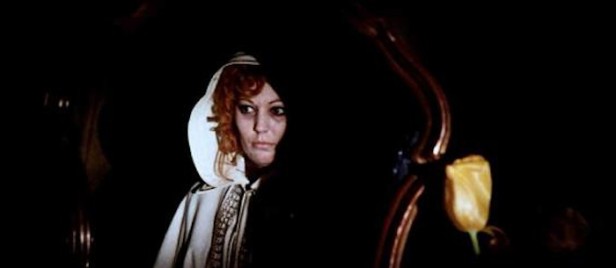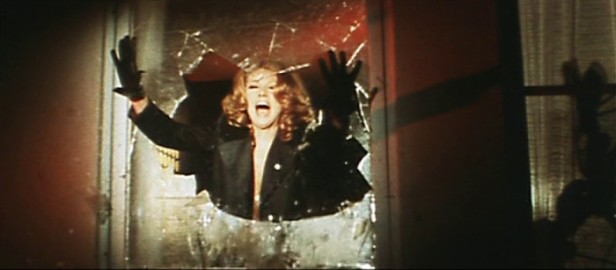Original title: Sette scialli di seta gialla
This lesser known giallo may be wholly derivative (its high fashion milieu evokes Mario Bava’s classic 6 donne per l’assassino/Blood and Black Lace (1964), its English language title wants us to think of both Edgar Allan Poe and Dario Argento’s then recent Il gatto a nove code/The Cat O’Nine Tails (1971), both films also featuring someone murdered by being pushed in front of a train, and its plot, as writer Darrell Buxton noted in the book Son of Unsung Horrors, owes much to Henry Hathaway’s 23 Paces to Baker Street (1956)) but it proves hugely entertaining all the same. This is due in part to Sergio Pastore’s vigorous, sometimes eye-watering direction (the man loved his zoom lens…) put mainly to the killer’s crazy modus operandi, which is again reminiscent of another film, in this case, the Bela Lugosi-starring The Devil Bat (1940).
The plot is as convoluted as you could wish for from a giallo. Fashion models (cue the Bava connection) are being murdered in the most bizarre fashion – each victim is sent a yellow shawl (the Italian title translates as Seven Yellow Silk Shawls) which has been laced with a chemical that attracts the attention of the eponymous feline. It, in turn, has its claws dipped in deadly curare and the victims are killed when the enraged cat scratches them. The first victim, Paola, had been in a relationship with a blind composer, Peter Oliver (Anthony Steffen). The Argento film had also featured a blind protagonist and, like Karl Malden’s character, overhears a conversation that might shed light on the mystery. Unfortunately, he’s interrupted by a groovy 70s hippy girl belting out loud rock music on the jukebox and the final part of the conversation is missed. With his faithful butler Burton (Umberto Raho), he manages to track the killer feline to tracks Susan (Jeannette Len), who swans about town in a not-at-all suspicious white cape and seems to suffer personal hygiene issues, who is in turn murdered before she can spill the beans. The killer turns out to be the usual sexually motivated maniac, jealous of another relationship that Paola had been in and setting up the other killings to throw the police off the scent.

For all its magpie tendencies – maybe even because of them – The Crimes of the Black Cat is a lot of trashy fun. Familiar faces like Giacomo Rossi Stuart, Sylva Koscina and Annabella Incontrera pepper the supporting cast (the expected bottle of the otherwise ubiquitous J&B whiskey is notably absent though, or else it’s very well hidden), the unusual Copenhagen locations are a definite plus, the plot is the usual heady stew of sex, violence and Manuel De Sica’s rock music score is heavy on the wah wah guitar. What’s not to love?
We could probably have done with the excitable Pastore’s tendency to punctuate each murder with his zoom lens pulsating in and out on the face of the victim and he could, perhaps, have gone a little easier on the whip pans, but all just adds to the film’s craziness. And crazy is most certainly the word for The Crimes of the Black Cat. As well as the outrageously over-complicated murder technique, we have more suspects than you can really keep up with (it feels like everyone is in the frame at some point or other), Peter complaining of Susan’s “fetid” body odour, and the startling realisation that, when he’s not out sleuthing, Peter seems to be rescoring Lucio Fulci’s Una lucertola con la pelle di donna/Lizard in a Woman’s Skin (1971) judging by what we see on his Steenbeck. The final moments are particularly odd when the killer’s identity and motivations are revealed – it doesn’t make a lick of sense really but somehow, given all the other eccentricities going on around it, it almost seems to be the only possible answer to the mystery.

For the most part, the murders, that incessant zoom lens aside, are par for the 1972 course, though Pastore saves something particularly nasty for the final act. By 1972, it was becoming de rigueur for any tale of serial murder to feature at least one Psycho (1960)-derived shower scene but here Pastore, with the help of make-up artist Renzo Francioni, goes where Hitchcock either couldn’t or wouldn’t go with a notably gory murder scene. It’s crudely done, even by the standards of the day, but coming out of the blue as it does it’s an effective shock moment.
One could never accuse Pastore’s film of being in any way original though curiously, with its slow-motion window-smashing finale it anticipates many similar scenes in Argento’s later films – Profondo Rosso/Deep Red (1975), Suspiria (1977), Inferno (1980), Tenebre (1982) and Phenomena (1985) are just some of the many examples of death or injury by window in his films. We never got to see if Pastore, who died too young at the age of just 55 in 1987, would go on to develop these kinds of obsessions himself. He made a dozen films in many genres during his short career and his only other giallo was his penultimate film, Delitti, released the year he died. That said, it clearly owes much to The Crimes of the Black Cat with its story of a killing claiming seven victims using a particularly venomous snake imported from Martinique. It’s a shame he didn’t make more gialli during the heyday of that uniquely Italian blend of sex, violence and head-scratching plotting. The Crimes of the Black Cat isn’t as stylish as Bava or Argento’s films, but its wildly improbable pick-and-mix plot, crazed camerawork and first rate cast of Italian exploitation dependables make it a film that deserves to be better known and better loved than it currently seems to be.
As the Italians and the Spanish cranked out the gialli, the gore content became more revolting and the films’ less concerned with mystery and suspense. Argento led the parade. The shower scene in Cat is so disgusting I had to turn away. Today, TV shows Hannibal and Criminal Minds and their kind have replaced the gialli.
LikeLiked by 1 person